ภาวะ Proteinuria ที่เกิดจาก Hypertrigly-ceridemia ในสุนัขพันธุ์ Miniature Schnauzer
สามารถอ่านได้ใน Eva Furrow
ภาวะ proteinuria ที่เกิดจาก hypertriglyceridemia เป็นความผิดปกติที่พบได้บ่อยในสุนัขพันธุ์ Miniature Schnauzer แต่ไม่ค่อยเป็นที่รู้จักกัน บทความนี้จะมาสรุปถึงวิธีการตรวจวินิจฉัยและการรักษาโดย Dr. Eva Furrow (แปลโดน น.สพ. พีระ มานิตยกุล)
Article

ประเด็นสำคัญ
ภาวะ Hypertriglyceridemia แบบปฐมภูมิเกิดได้บ่อยในสุนัขพันธุ์ Miniature Schnauzer ส่งผลให้เกิด proteinuria, glomerular lipid thromboemboli และพยาธิสภาพอื่นๆ ต่อ glomerulus
สุนัขที่มี hypertriglyceridemia ไม่จำเป็นจะต้องตรวจเจอ azotemia หรือ hypoalbuminemia หากตรวจพบมักจะมีสาเหตุมาจากอย่างอื่น
Hyperadrenocorticism เป็นหนึ่งในโรคที่วินิจฉัยแยกแยะเมื่อพบ hypertriglyceridemia และ hypoalbuminemia
การรักษาประกอบด้วยการให้อาหารไขมันต่ำ หรืออาจให้ยาลดไขมันร่วมด้วย ส่วนภาวะ proteinuria สามารถควบคุมด้วยการให้ยาที่ยับยั้ง renin-angiotensin-aldosterone system
บทนำ
Hypertriglyceridemia แบบปฐมภูมิ หรือ familial idiopathic hypertriglyceridemia เป็นโรคที่เกิดได้บ่อยแต่ไม่ค่อยตรวจพบในสุนัขพันธุ์ Miniature Schnauzers โดยมีอุบัติการณ์เกิดโรคสัมพันธ์กับอายุของสุนัข สุนัขที่มีอายุน้อยกว่า 3 ปีจะอยู่ที่ 15% และสุนัขที่อายุมากกว่า 9 ปีจะมีโอกาสพบถึง 75% [1] ภาวะ hypertriglyceridemia จะเพิ่มความเสี่ยงต่อการเกิดตับอ่อนอักเสบ, gallbladder mucocele และค่าเอนไซม์ตับที่สูงขึ้น [2][3][4] เมื่อไม่นานมานี้พบว่าภาวะ hypertriglyceridemia มีส่วนเกี่ยวข้องกับ proteinuria และพยาธิสภาพของ glomerulus ใน Miniature Schnauzer ด้วย [5][6][7]
Miniature Schnauzers ที่มีภาวะ hypertriglyceridemia แบบปฐมภูมิ ประมาน 50% มีภาวะ proteinuria ซึ่งในสายพันธุ์นี้มีค่า fasting serum triglycerides สัมพันธ์กับ UPC ratio อย่างมาก [5][6] นอกจากนี้การตรวจชิ้นเนื้อไตของสุนัขพันธุ์ Miniature Schnauzers ที่มีภาวะ proteinuria ร่วมกับ hypertriglyceridemia พบว่ามี lipid thromboemboli (รูปที่ 1a,1b,1c,1d ) [7] จากรอยโรคที่พบสามารถบอกได้ว่า ภาวะ hypertriglyceridemia น่าจะเป็นสาเหตุของการเกิดความผิดปกติใน glomerulus มากกว่าที่ความผิดปกติของ glomerulus ทำให้เกิดhypertriglyceridemia ในอันดับต่อไปจะกล่าวถึงลักษณะ ผลที่ตามมา การตรวจวินิจฉัย และการรักษา
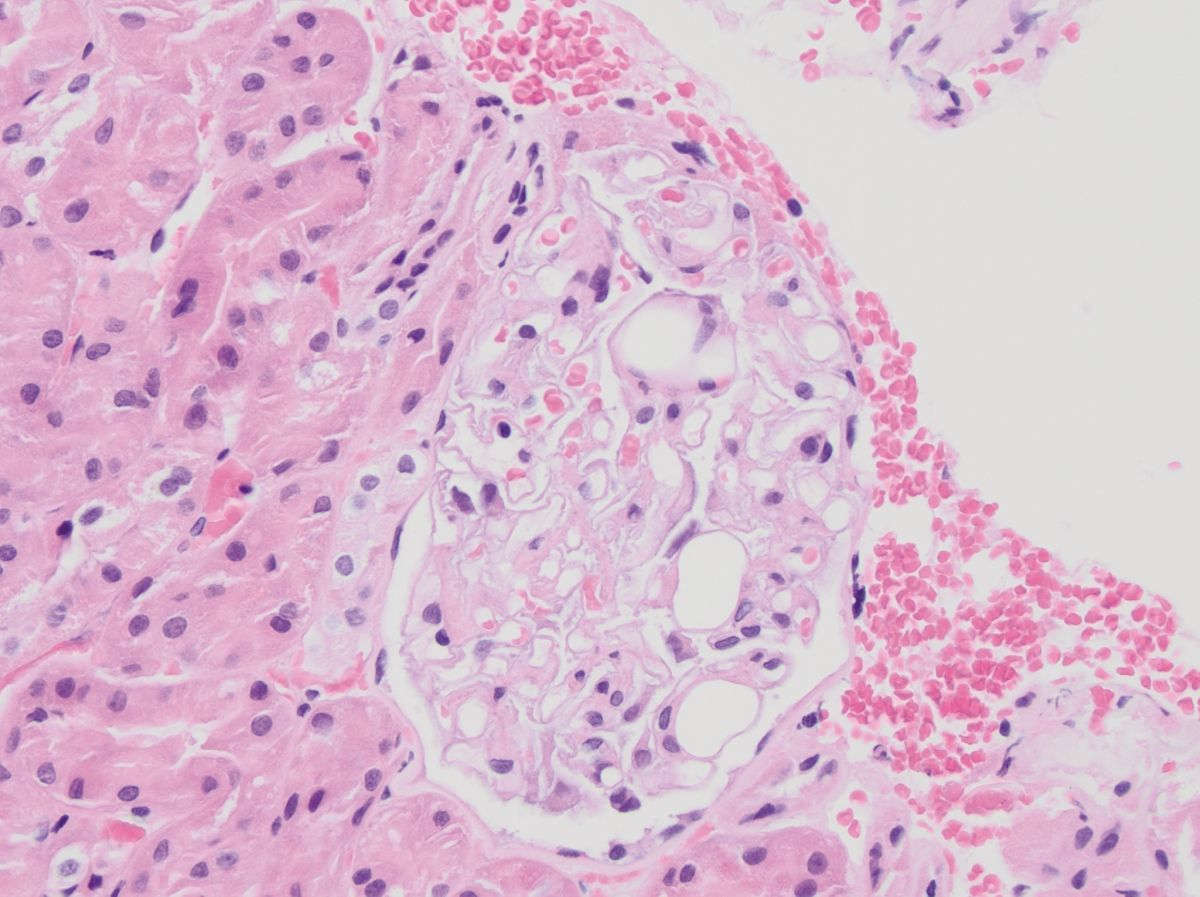
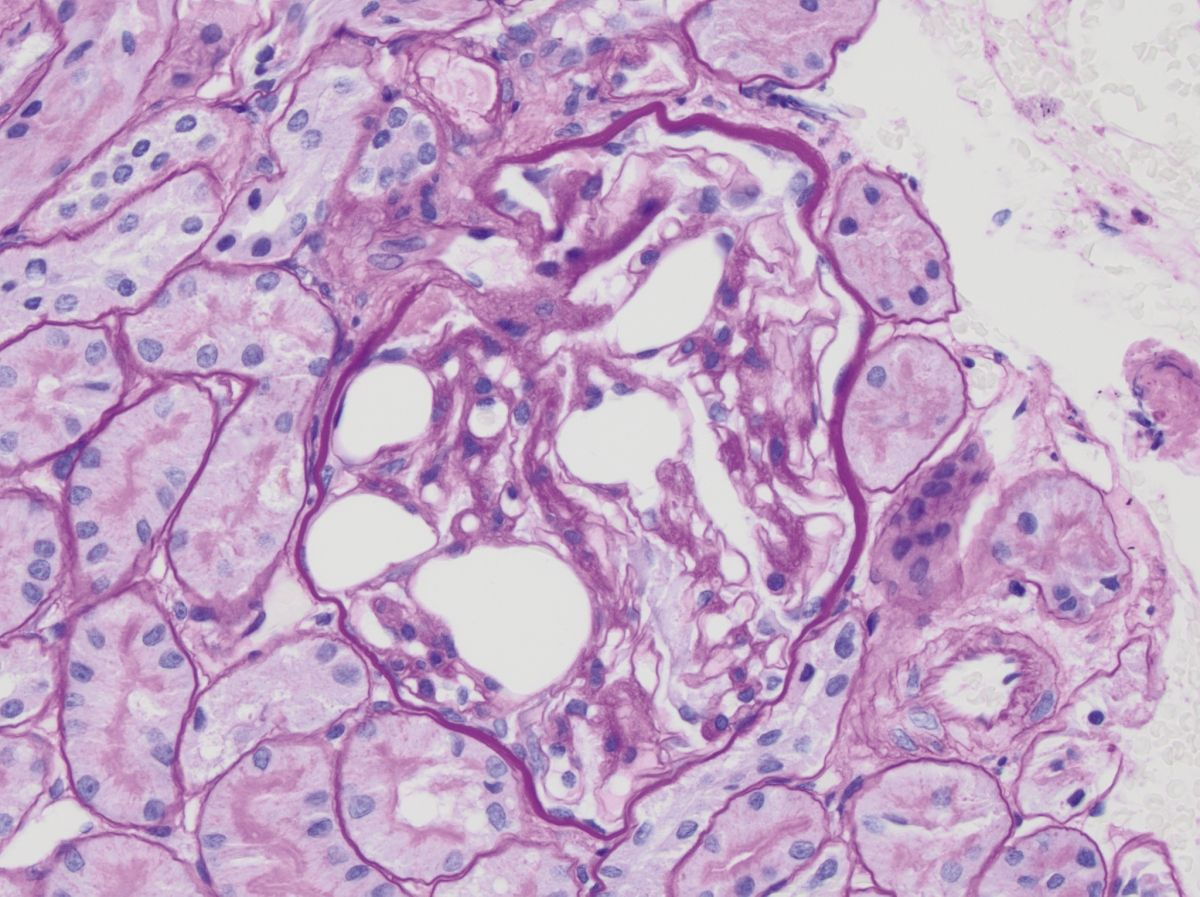

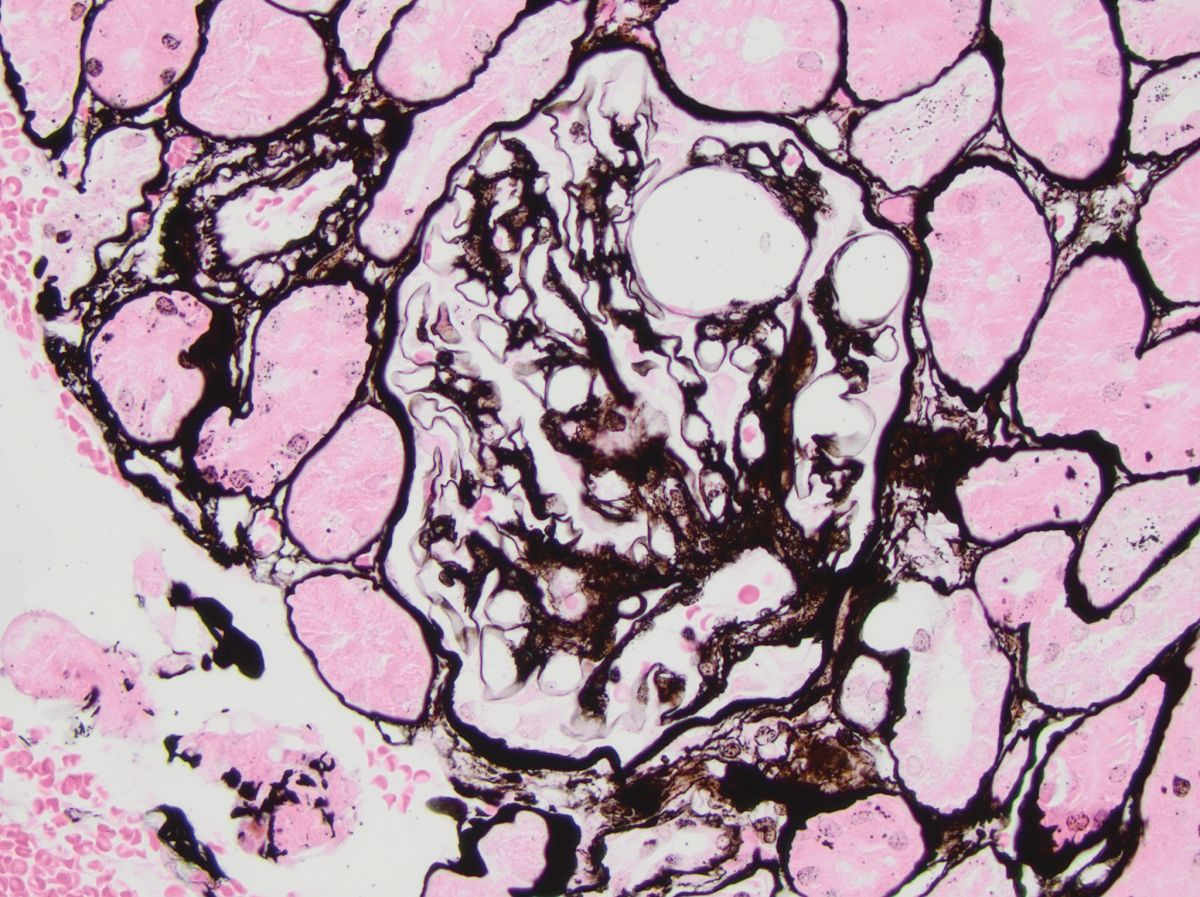
ลักษณะพยาธิสภาพทางคลินิก
การแสดงออกทางคลินิกในกรณีของภาวะ proteinuria จาก hypertriglyceridemia อยู่ในตารางที่ 1 ดังที่ได้กล่าวมาตอนต้นว่าภาวะนี้พบได้มากในสุนัขพันธุ์ Miniature Schnauzer ที่โตแล้วจนสูงวัย [5] ไม่มีความแตกต่างกันระหว่างประชากรเพศผู้และเพศเมีย หากไม่มีโรคอื่นแทรกซ้อน สุนัขจะไม่แสดงอาการเจ็บป่วย [5][6] อาจพบไขมันสะสมบริเวณดวงตาได้จากภาวะ hypertriglyceridemia [8] การวินิจฉัยว่าสุนัขมีภาวะ proteinuria จาก hypertriglyceridemia มักเกิดจากความบังเอิญเมื่อทำการตรวจปัสสาวะในการตรวจร่างกายประจำปีหรือตรวจรักษาโรคอื่นๆ
| สิ่งที่เข้าข่าย | สิ่งที่ไม่เข้าข่าย | |
| การตรวจปัสสาวะ |
|
|
| UPC |
- Fasting triglyceride concentrations อยู่ที่ 100-400 mg/dL (1.1-4.5 mmol/L) จะพบภาวะ mild proteinuria และ UPC < 2 - Fasting triglyceride concentrations > 400 mg/dL (> 4.5 mmol/L) จะพบภาวะ proteinuria และ UPC > 2 |
|
| Serum chemistry |
|
|
| Complete blood count |
|
|
*ผล proteinuria จาก Dipstick test มีความน่าเชื่อถือต่ำ ถึงแม้ผลตรวจจะออกมาว่าเป็น trace proteinuria แต่หากเป็นปัสสาวะที่เจือจาง อาจหมายถึงภาวะที่อันตรายได้ (10)
ผลการตรวจทางห้องปฏิบัติการที่พบได้ในภาวะ proteinuria จาก hypertriglyceridemia สามารถดูได้จาก ตาราง 1 ความรุนแรงของภาวะ proteinuria จะขึ้นอยู่ค่า fasting serum triglyceride [5][6] พบว่าสุนัข Miniature Schnauzer ที่มีภาวะ mild hypertriglyceridemia (100-400 mg/dL, 1.1-4.5 mmol/L) ประมาน 25-41% จะมี proteinuria ที่มี UPC < 2 โดยมาก ในขณะที่สุนัขที่มีภาวะ moderate หรือ severe hypertriglyceridemia (> 400 mg/dL, > 4.5 mmol/L) ประมาณ 85-88% จะมี proteinuria ที่มี UPC > 2 และอาจมากกว่า 5 ได้ ค่าความถ่วงจำเพาะจะพบได้หลากหลาย เหมือนกับสุนัขพันธุ์เดียวกัน อายุเท่ากัน ที่ไม่ได้มีภาวะ proteinuria จาก hypertriglyceridemia ตะกอนของปัสสาวะที่ตรวจจะเป็น inactive urine sediment
ภาวะ proteinuria ที่เกิดจาก hypertriglyceridemia จะไม่เกี่ยวข้องกับ hypoalbuminemia และ azotemia [6] ค่าปกติของ serum creatinine ในสุนัข Miniature Schnauzer จะ < 1.0 mg/dL, 88 μmol/L [6][9]
โอกาสพบ hypercholesterolemia ในสุนัขที่มีภาวะ mild hypertriglyceridemia พบได้ยากกว่าสุนัขที่มีภาวะ moderate ถึง severe hypertriglyceridemia โดยพบใน 40% ของสุนัขที่มีค่า serum triglyceride > 400 mg/dL , > 4.5 mmol/L [1] นอกจากนี้สุนัขที่มีภาวะ moderate ถึง severe hypertriglyceridemia ประมาณ 60% ยังพบค่า enzyme ตับที่สูงขึ้น ได้แก่ alkaline phosphatase และ enzyme ตัวอื่นอีกอย่างน้อย 1 ชนิด [4] น่าจะมีสาเหตุจากการที่มีไขมันมาสะสมที่ตับ ค่าเม็ดเลือดต่างๆไม่มีการเปลี่ยนแปลง แต่อาจพบ mild thrombocytosis (ค่า platelet count อยู่ที่ 400-500 x 103/μL) ซึ่งเป็นปกติในสุนัข Miniature Schnauzer สูงอายุ [6]
การตรวจวินิจฉัย
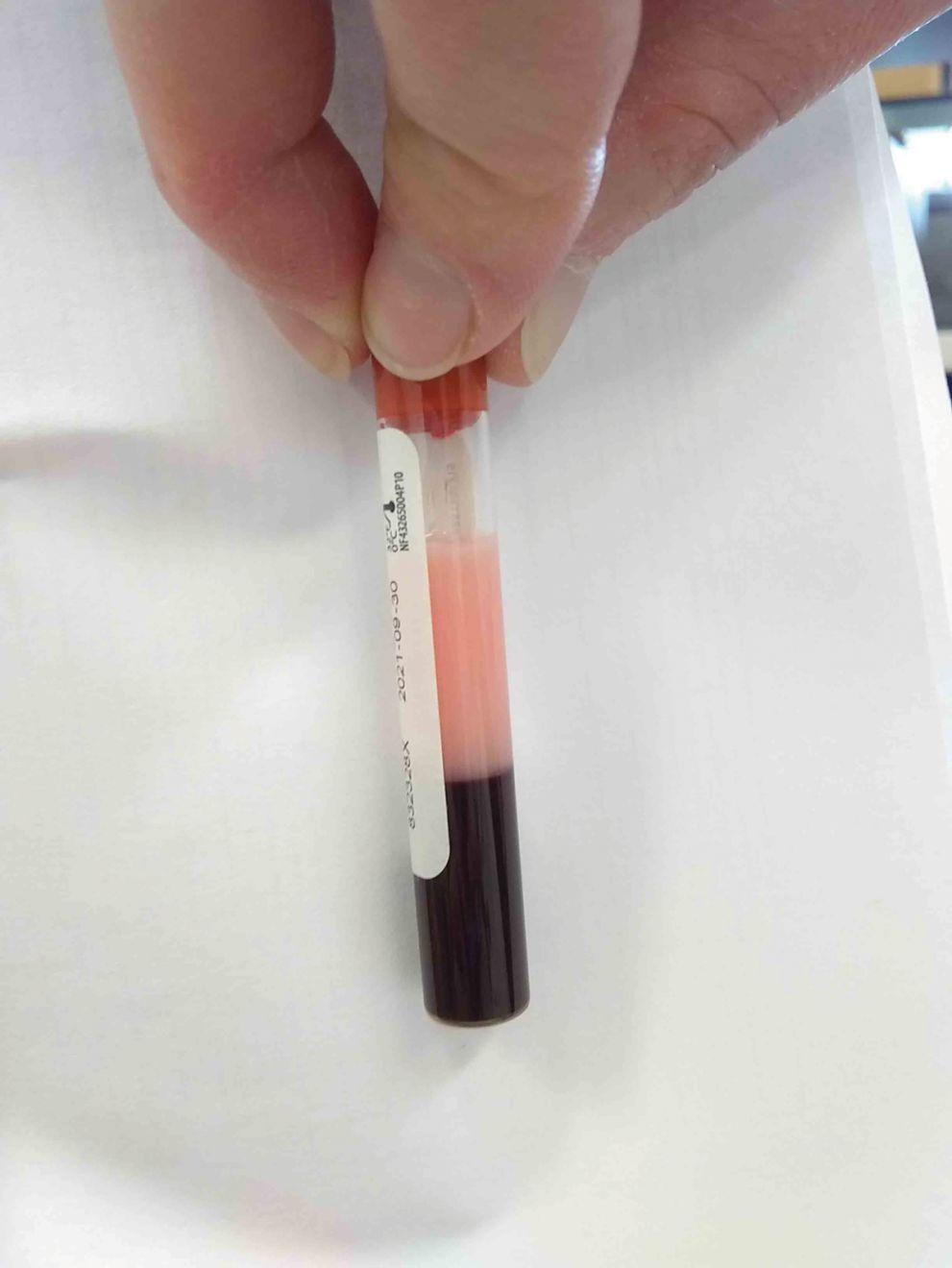
การตรวจพบ hypertriglyceridemia และ proteinuria ใน Miniature Schnauzer คือกระบวนการสำคัญในการวินิจฉัย ภาวะ proteinuria ที่เกิดจาก hypertriglyceridemia แต่ในขณะเดียวกัน สัตวแพทย์ยังต้องวินิจฉัยแยกแยะความผิดปกติอื่นออกไปด้วย ขั้นตอนในการวินิจฉัยอย่างง่ายอยู่ใน (ตาราง 2) ค่า serum chemistry (รูป2) และการตรวจปัสสาวะคือกุญแจสำคัญในการตัดสาเหตุของ proteinuria จาก post-renal และ pre-renal ทั้งยังบ่งชี้ถึงความผิดปกติอื่นๆ เช่น hypoalbuminemia azotemia ที่แสดงถึงความเสียหายรุนแรงของ glomerulus [11][12] ประวัติการรักษาด้วยยากลุ่ม corticosteroids หรือ phenobarbital รวมถึงโรคอื่นๆที่ ส่งผลให้เกิดภาวะ hyperlipidemia ได้ [13] รวมถึงโรคอื่นๆ เช่น เบาหวาน hyperadrenocorticism และ hypothyroidism มีผลให้เกิดภาวะ proteinuria ได้เช่นกัน [14][15][16]
|
ขั้นตอนที่ 1 ประเมินภาวะ Pre-renal , Post-renal proteinuria (11)
|
|
ขั้นตอนที่ 2 ประเมินหาสาเหตุอื่นๆที่อาจเกี่ยวข้องกับโรคที่อันตรายกับไต (12)
|
|
ขั้นตอนที่ 3 ประเมินหาสาเหตุอื่นที่เกี่ยวข้องกับ hyperlipidemia (17)
|
*Note: *สุนัขที่มีภาวะ hyperadrenocorticism และ hypertriglyceridemia แบบปฐมภูมิ สามารถพบความผิดปกติจากการตรวจวินิจฉัยได้คล้ายกัน เช่น lipidemia, ค่า alkaline phosphatase และ enzyme ตับตัวอื่นสูงขึ้น รวมถึง proteinuria การซักประวัติอย่างละเอียดจะช่วยวินิจฉัยแยกแยะได้
ภาวะ Hyperadrenocorticism หรือ Cushing จะวินิจฉัยแยกแยะได้ยากจาก hypertriglyceridemia แบบปฐมภูมิ เพราะมีค่าเอนไซม์ตับที่สูงคล้ายกัน หากตรวจร่างกายพบลักษณะที่จำเพาะต่อ Cushing เช่น alopecia hyperpigmentation ท้องหย่อนยาน กินอาหาร/น้ำมาก และ ปัสสาวะมาก ให้พิจารณาทำ low dose dexamethasone suppression test เพื่อยืนยันภาวะ hyperadrenocorticism [17] หากว่าการตรวจร่างกายไม่พบลักษณะที่บ่งชี้ถึง Cushing สามารถใช้ urine cortisol-to-creatinine ratio เพื่อตัดข้อสงสัยได้ ภาวะ mild hypertriglyceridemia ยังสามารถพบได้ในสุนัขที่เป็นโรคอ้วน ตับอ่อนอักเสบ และท่อน้ำดีอุดตัน [13] [18]
ท้ายที่สุดแล้วการวินิจฉัยภาวะ proteinuria ที่เกิดจาก hypertriglyceridemia คือการวินิจฉัยแบบตัดสาเหตุอื่นออกไป ในขั้นตอนสุดท้ายคือการทำ renal biopsy เพื่อนำชิ้นเนื้อไตไปย้อมสีด้วยเทคนิคพิเศษต่างๆ (รูป 1a 1b 1c 1d) [7] หากพบลักษณะของ glomerular lipid thromboemboli จะบ่งชี้ถึงความเสียหายที่เกิดจากไขมัน อาจพบร่วมกับ segmental glomerulosclerosis หรือไม่ก็ได้ หากส่องตรวจแล้วไม่พบการสะสมของไขมัน หรือมีรอยโรคชนิดอื่นปรากฏร่วมกัน สามารถอนุมานได้ว่าภาวะ proteinuria มีสาเหตุมาจากอย่างอื่น สิ่งสำคัญที่ควรรู้คือ 1 ใน 5 ของสุนัข Miniature Schnauzer ที่ผ่านการ renal biopsy พบว่ามีภาวะ immune-complex mediated glomerulonephritis [7] ซึ่งตอบสนองได้ดีต่อการรักษาด้วยยากดภูมิคุ้มกัน [19] การตัดสินใจทำ renal biopsy ในสุนัขที่สงสัยภาวะ proteinuria ที่เกิดจาก hypertriglyceridemia ควรระวังโรคอื่นที่อาจทำให้เกิดภาวะแทรกซ้อนจากการผ่าตัดได้ เช่น severe hemorrhage [20]
การรักษา
การตรวจพบ proteinuria และ hypertriglyceridemia ในสุนัข miniature schnauzer ไม่เพียงพอต่อการวินิจฉัยภาวะ hypertriglyceridemia-associated proteinuria หากไม่ตัดสาเหตุอื่นๆ ออกก่อน
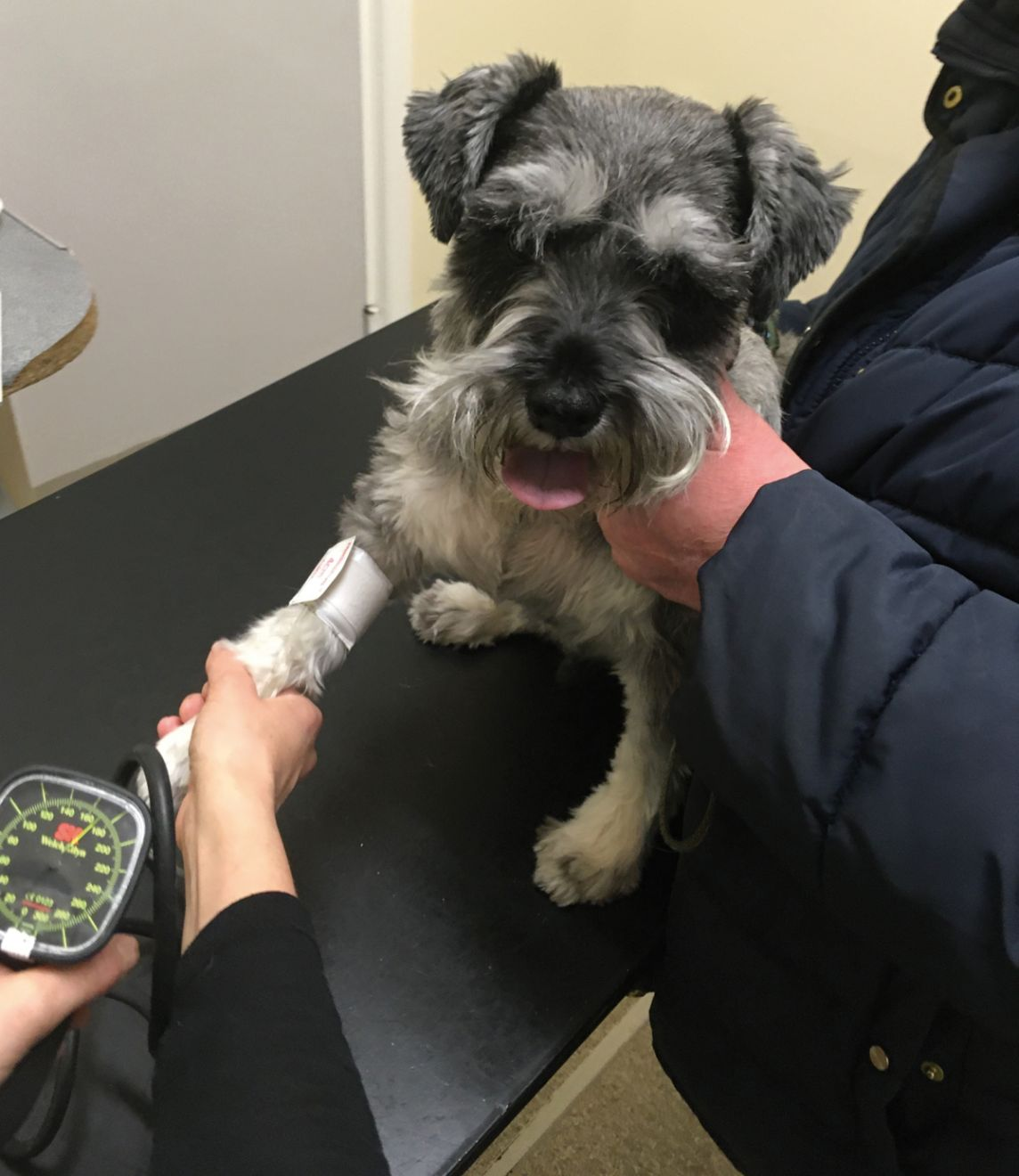
การรักษาภาวะ proteinuria ที่เกิดจาก hypertriglyceridemia ในสุนัขพันธุ์ Miniature Schnauzer ไม่ได้มีการค้นคว้าถึงวิธีการรักษาที่เหมาะสมที่สุด แต่การจัดการกับภาวะ hypertriglyceridemia จากข้อมูลในคนและสัตว์ฟันแทะจะมีความสำคัญมาก เริ่มโดยการให้อาหารที่จำกัดปริมาณไขมัน (ไขมันน้อยกว่า 25 กรัม ต่อพลังงาน 1,000 Kcal) [13] การจำกัดปริมาณโปรตีนในสุนัขที่มี ภาวะ proteinuria ที่เกิดจาก hypertriglyceridemia ยังไม่มีข้อมูลยืนยันว่าจะช่วยได้หรือไม่ [21] หลังจากได้ให้อาหารไขมันต่ำไปแล้ว 2 เดือนหากทำการเจาะเลือดแล้วยังพบค่า fasting serum triglyceride ยังคงสูงอยู่ ให้เริ่มยากลุ่ม fibrate เพื่อช่วยลดอันตรายของความเสี่ยงการเกิด proteinuria และ ตับอ่อนอักเสบ [2][5][6] จากการที่ระดับ serum triglyceride > 400 mg/dL (> 4.5mmol/L) ยา Bezafibrate มีประสิทธิภาพดีในการลดระดับของ triglyceride ในกระแสเลือดสุนัขให้กลับมาอยู่ในระดับปกติได้ใน 30 วัน [22] ขนาดที่แนะนำคือ 50 mg ทุก 24 ชั่วโมง โดยการกิน
สำหรับสุนัขหนักน้อยกว่า 12 kg, 100 mg สำหรับสุนัข หนัก 12.5-25 kg และ 200 mg สำหรับสุนัขหนักมากกว่า 25 kg Bezafibrate อยู่ในรูปแบบของยาเม็ดที่ค่อยๆปล่อยตัวยาออกมา และผลิตมาในขนาด 200 mg ถึงแม้จะต้องแบ่งยาสำหรับสุนัขหนักน้อยกว่า 25 kg ก็ยังให้ผลที่ดีในการลด triglyceride สามารถใช้ยา fenofibrate ที่ขนาด 2-4 mg/kg ทุก 24 ชั่วโมง [23] หรือ clinofibrate ขนาด 10 mg/kg ทุก 12 ชั่วโมงแทนได้ [24] ผลข้างเคียงที่เด่นชัดของยากลุ่มนี้ในคนคือ myopathy และ hepatotoxicity แต่ยังไม่พบในสุนัขที่ได้รับยาตามขนาดที่กล่าวไว้ด้านบน มีการเสนอแนะให้เสริมกรดไขมัน omega-3 และ niacin เพื่อช่วยรักษา hyperlipidemia แต่ยังไม่มีการทดสอบทางประสิทธิภาพที่ชัดเจนเพียงพอ [13]
การรักษาภาวะ proteinuria ด้วยยาที่ขัดขวาง renin-angiotensin-aldosterone system สามารถทำได้ในรายที่ค่า UPC ratio > 0.5 อย่างต่อเนื่อง [21] โดยยาที่ใช้อาจเป็นกลุ่มที่ขัดขวาง angiotensin converting enzyme อย่าง enalapril, benazepril ที่ขนาด 0.5 mg/kg ทุก 24 ชั่วโมงหรือกลุ่ม angiotensin receptor blocker เช่น telmisartan ขนาด 1 mg/kg วันละครั้ง หลังเริ่มยาไปแล้ว 1-2 สัปดาห์ [21] ควรทำการตรวจค่า UPC, serum creatinine, serum potassium และ ความดันโลหิตซ้ำอีกครั้ง ยากลุ่ม antithrombotic agent มีการใช้กันแพร่หลายในกรณีของสุนัขที่มีภาวะ proteinuric glomerular disease [6] แต่จากการประเมินสุนัข Miniature Schnauzer ที่มีภาวะ proteinuria ที่เกิดจาก hypertriglyceridemia ยังไม่พบการเกิดการอุดตันจากลิ่มเลือดแต่อย่างไรเนื่องจากมีตัวอย่างน้อย สัตวแพทย์จึงต้องใช้วิจารณญาณในการใช้ยา antithrombic agent ยาลดความดันควรเลือกใช้เมื่อสุนัขมีความดัน > 150 mmHg ต่อเนื่อง (รูปที่ 3) [21] อย่างไรเนื่องจากมีตัวอย่างน้อย สัตวแพทย์จึงต้องใช้วิจารณญาณในการใช้ยา antithrombic agent ยาลดความดันควรเลือกใช้เมื่อสุนัขมีความดัน > 150 mmHg ต่อเนื่อง (รูปที่ 3) [21]
พยากรณ์โรค
โดยทั่วไปจัดว่าดี กรณีศึกษาตามยาวนี้เป็นการติดตามสุนัขพันธุ์ Miniature Schnauzer ที่มีภาวะ proteinuria ที่เกิดจาก hypertriglyceridemia โดยมีสุนัขตัวอย่างเพียง 8 ตัว เป็นเวลาเฉลี่ย 18 เดือน [6] โดยในขณะที่เฝ้าสังเกตไม่พบอาการที่แย่ลงของโรคไตหรือการเสียชีวิตจาก ภาวะ proteinuria ที่เกิดจาก hypertriglyceridemia นอกจากนี้ยังไม่พบความเสียหายต่อหัวใจหรือเกิดภาวะ hypercoagulopathy จากการตรวจการทำงานของ antithrombin 3 [6]
กล่าวโดยสรุป Hypertriglyceridemia แบบปฐมภูมิมีโอกาสเกิดง่ายในสุนัขพันธุ์ Miniature Schnauzer ที่โตเต็มวัยจนถึงชรา และพบร่วมกับ glomerular–range proteinuria มีหลักฐานว่าภาวะ proteinuria เกิดจากความเสียหายต่อไตโดยไขมัน พบรอยโรค lipid emboli จากการตรวจชื้นเนื้อไตที่ได้จากสุนัขพันธุ์ Miniature Schnauzer ที่มีภาวะ proteinuria และ hypertriglyceridemia ภาวะนี้มักไม่แสดงอาการทางคลินิก หรือพบความผิดปกติรุนแรงของไต เช่น hypoalbuminemia, azotemia และลิ่มเลือดอุดตัน เมื่อตรวจพบภาวะ proteinuria และ hypertriglyceridemia พร้อมกันในสุนัขสายพันธุ์นี้ สัตวแพทย์จำเป็นต้องตัดสาเหตุอื่นเช่น hyperadrenocorticism ให้ได้ก่อนที่จะสรุปว่าเป็น ภาวะ proteinuria ที่เกิดจาก hypertriglyceridemia การรักษาประกอบไปด้วยการจัดการภาวะ hypertriglyceridemia ด้วยอาหาร และอาจเพิ่มยากลุ่ม fibrate การยับยั้ง renin-angiotensin-aldosterone system เพื่อลดภาวะ proteinuria จากข้อมูลที่มีจำกัดพบว่าการพยากรณ์โรคค่อนข้างดีเยี่ยม แต่ถ้าตรวจพบ ภาวะ hypoalbuminemia, azotemia และ isosthenuria อย่างต่อเนื่อง จำเป็นต้องหาสาเหตุอื่นที่ซ่อนอยู่
Eva Furrow
VMD, PhD, Dipl. ACVIM
สหรัฐอเมริกา
Dr. Furrow qualified from the University of Pennsylvania and after completion of a small animal internship at the same establishment she moved to the Midwest for a residency in internal medicine followed by a PhD on metabolic and genetic risk factors for urinary stones in dogs, both at the University of Minnesota. She is currently an assistant professor of internal medicine and genetics at the University of Minnesota, where her primary interests include genetic, urinary, endocrine and metabolic disorders.
แหล่งอ้างอิง
- Xenoulis PG, Suchodolski JS, Levinski MD, et al. Investigation of hypertriglyceridemia in healthy Miniature Schnauzers. J Vet Intern Med 2007;21:1224-1230.
- Xenoulis PG, Levinski JS, Suchodolski JS, et al. Serum triglyceride concentrations in Miniature Schnauzers with and without a history of probable pancreatitis. J Vet Intern Med 2011;25:20-25.
- Kutsunai M, Kanemoto H, Fukushima K, et al. The association between gallbladder mucoceles and hyperlipidemia in dogs: a retrospective case control study. Vet J 2014; 199:76-79.
- Xenoulis PG, Suchodolski JS, Levinski MD, et al. Serum liver enzyme activities in healthy Miniature Schnauzers with and without hypertriglyceridemia. J Am Vet Med Assoc 2008;232:63-67.
- Furrow E, Jaeger JQ, Parker VJ, et al. Proteinuria and lipoprotein lipase activity in Miniature Schnauzer dogs with and without hypertriglyceridemia. Vet J 2016;212:83-89.
- Smith RE, Granick JL, Stauthammer CD, et al. Clinical consequences of hypertriglyceridemia-associated proteinuria in Miniature Schnauzers. J Vet Intern Med 2017;31:1740-1748.
- Furrow E, Lees GE, Brown CA, et al. Glomerular lesions in proteinuric Miniature Schnauzer dogs. Vet Pathol 2017;54:484-489.
- Crispin SM. Ocular manifestations of hyperlipoproteinaemia. J Small Anim Pract 1993;34:500-506.
- Chang Y-M, Hadox E, Szladovits B, et al. Serum biochemical phenotypes in the domestic dog. PLoS ONE 2016;11:e0149650.
- Zatelli A, Paltrinieri S, Nizi F, et al. Evaluation of a urine dipstick test for confirmation or exclusion of proteinuria in dogs. Am J Vet Res 2010;71:235-240.
- Lees GE, Brown SA, Elliott J, et al. Assessment and management of proteinuria in dogs and cats: 2004 ACVIM forum consensus statement (small animal). J Vet Intern Med 2005;19:377-385.
- IRIS Canine GN Study Group Diagnosis Subgroup; Littman MP, Daminet S, Grauer GF, et al. Consensus recommendations for the diagnostic investigation of dogs with suspected glomerular disease. J Vet Intern Med 2013;27:S19-S26.
- Xenoulis PG, Steiner JM. Lipid metabolism and hyperlipidemia in dogs. Vet J 2010;183:12-21.
- Herring IP, Panciera DL, Werre SR. Longitudinal prevalence of hypertension, proteinuria, and retinopathy in dogs with spontaneous diabetes mellitus. J Vet Intern Med 2014;28:488-495.
- Smets PMY, Lefebvre HP, Kooistra HS, et al. Hypercortisolism affects glomerular and tubular function in dogs. Vet J 2012;192:532-534.
- Gommeren K, van Hoek I, Lefebvre HP, et al. Effect of thyroxine supplementation on glomerular filtration rate in hypothyroid dogs. J Vet Intern Med 2009;23:844-849.
- Behrend EN, Kooistra HS, Nelson R, et al. Diagnosis of spontaneous canine hyperadrenocorticism: 2012 ACVIM consensus statement (small animal). J Vet Intern Med 2013;27:1292-1304.
- Tvarijonaviciute A, Barić-Rafaj R, Horvatic A, et al. Identification of changes in serum analytes and possible metabolic pathways associated with canine obesity-related metabolic dysfunction. Vet J 2019;244:51-59.
- IRIS Canine GN Study Group Established Pathology Subgroup; Segev G, Cowgill LD, Heiene R, et al. Consensus recommendations for immunosuppressive treatment of dogs with glomerular disease based on established pathology. J Vet Intern Med 2013;27 Suppl 1:S44-54.
- Vaden SL, Levine JF, Lees GE, et al. Renal biopsy: a retrospective study of methods and complications in 283 dogs and 65 cats. J Vet Intern Med 2005;19:794-801.
- IRIS Canine GN Study Group Standard Therapy Subgroup, Brown S, Elliott J, Francey T, et al. Consensus recommendations for standard therapy of glomerular disease in dogs. J Vet Intern Med 2013;27 Suppl 1:S27-43.
- de Marco V, Noronha KSM, Casado TC, et al. Therapy of canine hyperlipidemia with bezafibrate. J Vet Intern Med 2017;31:717-722.
- Kuehn NF. North American Companion Animal Formulary, 12th edition. North American Compendiums Inc. 2018
- Sato Y, Arai N, Yasuda H, et al. Clinofibrate improved canine lipid metabolism in some but not all breeds. J Vet Med Sci 2018;80:945-949.
บทความอื่นๆ ในประเด็นนี้
แบ่งปันบนโซเชียลมีเดีย